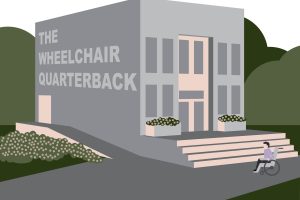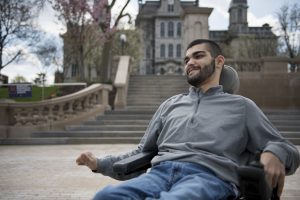InclusiveU looks for progress amid funding increase
InclusiveU looks for progress amid funding increase

Syracuse University’s efforts at creating a more diverse and inclusive campus have now gotten financial support from New York State specifically for the disability community.
New York State plans to restore $100,000 in funding in next year’s budget for the SU’s InclusiveU program, which provides students with intellectual and developmental disabilities the opportunity to attend college.
The boost in funding could impact not only the disability community on campus but also those with disabilities away from campus.
“We are continually taking a step back to see how the program can improve,” InclusiveU director Bud Buckhout said. “Any funding that is received helps us continue to make sure that we are a program that is centered around the students and meeting their needs, whether academically, socially or in the general campus community.”
New York state Sen. John Mannion, who helped secure the funding with Sen. Rachel May, said he views it through a broader lens. Mannion, chairman of the state’s Committee on Disabilities, said it’s important for the state to invest in the programs that invest in people with disabilities, like InclusiveU.
“It helps make sure that the voices of people with disabilities are heard and many of their ideas come to life,” Mannion said. He added that this helps measure whether programs are successful, especially considering unemployment among disabled Americans is as high as 70 percent. “We need to do everything we can to both harness their abilities and create job and career pathways.”
Buckhout said the funding will help the School of Education program accomplish just that. Buckhout said he wants to constantly improve with fitting the needs of individual students, academically and socially. The program — which works closely with the school’s Center for Disability and Inclusion— is currently reviewing its procedures for working with prospective students, focusing on implementing a person-centered approach, Buckhout said.
He said once students arrive on campus, the ultimate goal is to develop individualized plans based on how they learn best, how they interact socially and their plans or goals for employment upon graduation.
The additional funding will help InclusiveU to further invest in supporting students in this way, said CDI assistant director Beth Myers. Along with more individualized planning, the funding will allow for better translation services, additional internship opportunities and more full-inclusive employment preparation for those graduating from the program, Myers said.
She said that while the current priority is staffing, there are other areas that directors hope to improve as well. Myers hopes to soon provide enhanced space for student support, a technology lending library, student scholarships — particularly for students in multiple marginalized positions, — additional supports for students living in the residence halls and enhanced transition coordination.
Buckhout envisions InclusiveU someday providing the technology necessary for some InclusiveU students to succeed on and off-campus. He also wants to offer additional scholarships, as students attending the InclusiveU program inherit about the same financial burden as SU students without disabilities.
“We are continually taking a step back to see how the program can improve,” Buckhout said. “Any funding that is received helps us continue to make sure that we are a program that is centered around the students and meeting their needs, whether academically, socially or in the general campus community.”
In recent years, the InclusiveU program has notably expanded, Myers said. This upcoming fall, the program will have over 100 students for the first time in eight years, Myers said. Along with expanding the number of students, Myers said, it’s important to enhance the student experience. To Myers, it’s about ensuring that students at InclusiveU have access to all parts of the University with the support they need.
In doing so, Myers said, the program intentionally stays connected to its established foundations. She, Buckhout and other directors at InclusiveU and CDI don’t want to create something new but instead help students access what the university offers, like academic options, Orange After Dark events and the extracurricular clubs and organizations on campus.
Mannion said expanding access is a fundamental motivation behind the legislation. Additional funding will allow InclusiveU more room to pivot, adjust and progress as a program, he said. But InclusiveU — and SU, in general — is not alone in this, he said; it’s society as a whole that must improve support.
“By that I mean buildings that are specifically designed to — at a minimum — make things more challenging for the disabled,” Mannion added.
The funding increase has coincided with widespread pressure on senators to address the lack of resources among disability resource centers at universities, said Paula Possenti-Perez, director of Syracuse’s Center for Disability Resources. In response, NY state senator Toby Ann Stavisky sponsored a bill to “enhance supports and services for students with disabilities for post-secondary success” and introduced it to universities on May 4.
Possenti-Perez said that the additional funding from the bill would be a big help to SU. The bill, which is currently in the finance phase, would expand support for students with disabilities, support programs that assist with transition planning, enhance disability training for faculty and improve the disability identification process, among other things. But some are concerned about whether the additional funding will reach students with disabilities or get lost in the shuffle, according to Possenti-Perez.
“My concern is once it gets through the state legislature and the governor signs, the state education department has to draft regulations. And how long will that take, I worry no funds will be released this year. And then we have to hope it gets funded next year,” Possenti-Perez said. “I think it happens. Sometimes funds get absorbed at an institutional level and the disability services offices don’t directly see their budgets go up.
“Clearly. I am providing anecdotal information, but it’s not hard to imagine,” Possenti-Perez added. She has experienced a lack of funding within Syracuse’s Center for Disability Resources and has been disappointed with the absence of support from state and federal governments. As a member of the Disability External Review Committee, Possenti-Perez looks forward to future phases enhancing SU’s financial commitment to accessibility and inclusion for people with disabilities. The goal is to make disability a campus-wide commitment, rather than the responsibility of a single office, she said.
Myers said InclusiveU, the Taishoff Center for Inclusive Higher Education and the Center for Disability Resources work for the same end goal: full inclusion on campus.
“We can all work together to push this agenda forward,” she said. “This is not work that should be isolated or isolating.”








